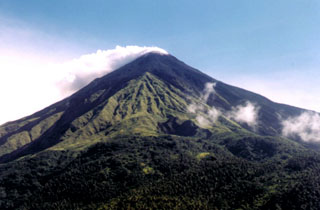Report on Karangetang (Indonesia) — August 1984
Scientific Event Alert Network Bulletin, vol. 9, no. 8 (August 1984)
Managing Editor: Lindsay McClelland.
Karangetang (Indonesia) Tephra ejection, lava flows, lahars; 20,000 evacuated
Please cite this report as:
Global Volcanism Program, 1984. Report on Karangetang (Indonesia) (McClelland, L., ed.). Scientific Event Alert Network Bulletin, 9:8. Smithsonian Institution. https://doi.org/10.5479/si.GVP.SEAN198408-267020
Karangetang
Indonesia
2.781°N, 125.407°E; summit elev. 1797 m
All times are local (unless otherwise noted)
Press sources reported that explosions 28 August and 5 September ejected dense ash clouds that rose to 4 km altitude. Ash and larger tephra fell over a wide area. Lava flows and lahars destroyed terraced rice fields and nutmeg orchards on the volcano's upper flanks. Magnitude 3-5 earthquakes had been felt since the beginning of September. About 25 shocks were felt near the volcano on 5 September, and some were also felt on nearby islands. By late 11 September, about half of Siau Island's 40,000 residents had been evacuated and officials warned people living on the lower flanks to be ready to leave quickly.
Geological Summary. Karangetang (Api Siau) volcano lies at the northern end of the island of Siau, about 125 km NNE of the NE-most point of Sulawesi. The stratovolcano contains five summit craters along a N-S line. It is one of Indonesia's most active volcanoes, with more than 40 eruptions recorded since 1675 and many additional small eruptions that were not documented (Neumann van Padang, 1951). Twentieth-century eruptions have included frequent explosive activity sometimes accompanied by pyroclastic flows and lahars. Lava dome growth has occurred in the summit craters; collapse of lava flow fronts have produced pyroclastic flows.
Information Contacts: UPI; DPA; AFP.

